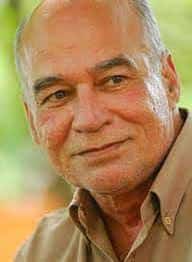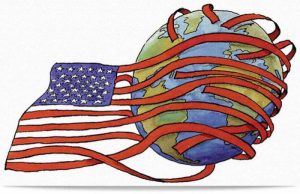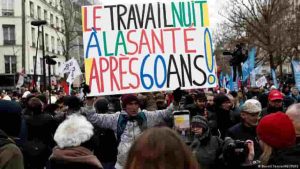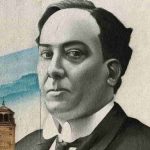
El siguiente texto fue leído por el autor el 21 de marzo de 2024 en la mesa redonda «La revolución y el pueblo: leninismo, estética y política», junto con Jason Barker y Tora Lane como co-panelistas, y Alexander Stagnell como presidente, celebrada como parte de la serie internacional de eventos Jornadas leninistas (27 de enero al 25 de mayo de 2024), organizado en conmemoración del centenario de la muerte de Vladimir I. Lenin. Se presenta ahora en una versión revisada y ligeramente editada.
De una revolución a otra: la dramaturgia del pueblo
Mel arxismo como el suelo bajo nuestros pies y el comunismo como el horizonte hacia el que adquieren sentido nuestras prácticas políticas. Marxismo y comunismo. Terreno indudable y horizonte insuperable: dos fuentes de realización de deseos que, a pesar de las señales en contrario, cuando todo lo demás se agita y se fragmenta a nuestro alrededor, se impresionan aún más obstinadamente.
Aquí hablo personalmente.
Al dirigirme a todos ustedes, es, quizás, un sentimiento compartido.
Porque hoy los hechos nos hablan en lenguas, razón suficiente para no permitir que los hechos hablen por sí mismos. Y, como sabemos, porque es un axioma del marxismo, no se pueden «ver» —y mucho menos escuchar— los hechos sin adoptar un punto de vista «de clase». Un punto de vista de clase, además, impregnado de contenido teórico. Porque, como también sabemos, ver bien, es decir, incisivamente, no es simplemente una cuestión empírica. Es uno de centralidad teórica. Se trata de estar dotados de la teoría correcta, de proporcionar al pensamiento y a la práctica las condiciones de visibilidad mediante las cuales las posibilidades puedan ser afirmadas, negadas, re-trazadas, y desde las cuales debemos intervenir en el mundo, y hacer un corte efectivo en el estado real de las cosas.
Hoy en día, cuando tomamos la medida de nuestro propio tiempo, experimentamos antagonismos de manera bastante tangible, pero la forma (política, estética, teórica) que están tomando sigue siendo inestable, poco confiable y oportunistamente enmarcada. Se habla tanto de «el pueblo», de la construcción de construcciones lingüísticas prefabricadas de mala calidad que enmarcan confusamente las cosas en términos de «la gente común contra la élite», «nosotros contra ellos», etc. Es precisamente aquí donde uno sospecharía que el «punto de vista de clase» —es decir, ver las cosas desde la posición del proletariado— está muy ausente hoy en día en cualquier movimiento emancipatorio arraigado. Articulaciones políticas desancladas de las condiciones materiales: donde lo que prevalece es el espectáculo de las consignas vacías y donde, como se decía, el «socialchovinismo» manda en el gallinero. Aquí es donde estamos hoy: sin fundamento, sin timón, horizontes oscurecidos.
La gente.
Que la mesa redonda de hoy no sea una concesión a nuestros tiempos maltrechos. No es prudente invadir el territorio del populismo, porque ni el marxismo ni el comunismo son hábilmente servidos por él.
Al mismo tiempo, sería erróneo pensar que la tradición de las luchas revolucionarias podría prescindir de la figura del pueblo. Las revoluciones de 1789, 1793, 1848, 1871, 1905, 1917, siguen un arco narrativo-histórico trazado por medio del «pueblo» (tanto como referente, es decir, «las masas en marcha», como Idea, es decir, el intento de presentar «el todo»). Es lo que reúne: los discursos de Jean-Paul Marat y Robespierre durante la secuencia revolucionaria jacobina de la Revolución Francesa; Babeuf y la «conspiración de los iguales» en el extremo del perro de la secuencia de la Revolución Francesa. Es lo que reúne las palabras de Jules Michelet, escribiendo en vísperas de 1848, que «el pueblo» es el actor principal de la revolución. Es lo que, además, une las revoluciones francesa y rusa. Ya que no es solo una nota a pie de página de la historia que los revolucionarios rusos estaban fascinados por el evento de la masa de personas que subieron al escenario político durante la Revolución Francesa. Incluso si el resultado fuera la consolidación de la burguesía, las cuestiones político-estratégicas en juego, inmanentes a la revolución (con respecto a sus vicisitudes, las complejas fuerzas de clase en juego y el papel político necesario para mantener unido el frágil alineamiento de las clases insatisfechas) se ponen de relieve con respecto al «Pueblo», tanto como Idea del todo como real multiplicidad. Es preguntarse: ¿cómo alinear a las clases oprimidas, fusionarlas en un todo, emancipándose colectivamente del yugo de antaño? Escribiendo en 1919, durante las multitudes de la guerra civil, con los logros revolucionarios frágiles, con gran parte de la revolución por lograr, Lenin trazaría un paralelo directo con la Revolución Francesa, afirmando que su grandeza radicaba en el simple hecho de que «logró despertar a las vastas masas del pueblo en defensa de sus conquistas y resistieron al mundo entero».
De una revolución a otra. Desde los años 1789-1794, en Francia, hasta 1917 en Rusia (y todos los acontecimientos insurreccionales espasmódicos que se produjeron en el medio), el «pueblo» muestra su elasticidad al proporcionar el arco narrativo de los acontecimientos revolucionarios.
Lo que planeo hacer en esta presentación es decir algo sobre la gente en las tradiciones marxistas, marxistas-leninistas. Sin embargo, quiero presentar esto mostrando la posición indecidible que tiene el «pueblo» dentro del marxismo/marxismo-leninismo. Indecidible, no sólo porque el Pueblo es un significante ambiguo; impreciso en su sentido que lo hace víctima de ser arrastrado de derecha a izquierda y de izquierda a derecha.
This we need not have a discussion about. Clear as it is.
Rather, I will speak in terms of the undecidable position that both the category and referent of the people has within the Marxist revolutionary tradition, based on whether one is operating on the strictly “theoretical” or political terrain of Marxism. Everything will hang, in fact, on the very terms I began with: Ground and horizon. Marxism and Communism. Because if Marxism still serves as a ground for us, it is as a theoretical fundament—a watchword for rigour, clear and precise analyses of our conjuncture. But Communism, as horizon? How are we to think it other than as speaking to our political vocation? As the focus imaginarius that promises a “classless society”, a society that promises the “all” of the people—what Marx and Lenin will refer to as the outcome of a “real people’s revolution”. Something I will return to near the end of my talk.
Now, forgive me. You will scratch your heads and say: “why present things dualistically in this way, David? Why draw a quite conventional distinction between a “theoretical” and “political” standpoint, when we all know Marxist-Leninism saw them as a unity?’ This after all is what gives Marxism both its explanatory and emancipatory power: the unity of theory and practice. This, for sure, is how things have stood. And fully acknowledging (as I began) that today a symptom of the political paralysis we face on parts of the Left, which borrows a thing or two from Populism, is the absence of any theoretical ground in the direct service of an emancipatory politics, I will nonetheless insist on what we can call a “cleft”, a split, with respect to two different standpoints—theoretical Marxism and political Communism – on the question of the people within Marxism, generally, and in the work of Lenin, in particular. This cleft, as I will describe it, alters the limitations and productivity of the term of the People with regards to politics and theory, though at the same time, this alteration will not constitute a “contradiction”, though it definitely produces a torsion. What, furthermore, it does bring to light is the discursive complexities surrounding how the people is at the same time operative and inoperative in Marxism and Marxism-Leninism.
Marx derides the category of “population” as an example of the “false” or “pseudo” concrete, for it comprises of multitudinous determinations, class differences, class relations and practices, etc. Starting with population—as what designates the people of a particular territory—will yield but a chaotic presentation.
At the end, I will offer an example of how, when thought from a strictly political viewpoint, as Lenin does in State and Revolution, the “people” as both a referent and an Idea, on the one hand, and a “class” politics, as a mode for thinking the stakes of emancipation, on the other, are not antithetical. History, and let’s say more precisely, the history of “emancipatory struggles”, provides much food for thought on this relation. It requires us to complexify how the two interweave (politically) even though from a theoretical viewpoint they just as quickly come apart. From a political viewpoint, we are thrown upon the old question surrounding the relation between the multiple and unity; that is, between the complex and multitudinous character of social relations and lines of antagonism in society, and the revolutionary imperative to organise, to lead a mass movement that, infused by its own multiplicity, effectively broaches the “all”. Something that Antonio Gramsci would have spoken of in terms of “the formation of a popular will”.
First, though, I will offer some short reflections on the scientific method of Marx, specifically focusing on Marx’s 1857 Introduction to the Grundrisse. And how, from a strictly theoretical viewpoint, there are clear reasons to be skeptical surrounding the idea of the People as effective for a rigorous critical analysis of social forms. The “1857 Introduction” by Marx has been held up by Marxists as the nearest thing approximating a method that Marx presented. It has been regarded as Marx’s contribution to a critical or, as Stuart Hall once framed it, as a “historical epistemology”.
In the section dedicated to the “Method of Political Economy”, Marx sets out to expose the fundamental defects of the scientific method of classical political economy. In part he demonstrates this by means of the category of the “population” (Bevölkerung), the standard starting point for classical political economy. Marx derides the category of “population” as an example of the “false” or “pseudo” concrete. Even if appearing as the real (wirchlichen) presupposition for all possible economic relations, the idea of “population” shows itself to be anything but “clear and distinct”. It comprises of multitudinous determinations (e.g. topographical distinctions (town/country), class differences (proletariat/bourgeoisie), class relations and practices, etc. It soon becomes evident that starting with population—as what designates the people of a particular territory—will yield but a chaotic presentation (Vorstellung). What is demanded is a forensic scrutiny of its constituent and multiple parts; according to which a unity (not simple, but complex) is a “concentration” of a diversity of elements (“a rich totality of many determinations and relations”). The category, which had once been seen in its concrete simplicity, is interrogated because it is abstract in its one-sidedness. A one-sidedness that must be redressed by showing how the real concrete is a concentration of multiple (often antagonistic) relations and contents.
Why is this passage significant in a discussion of Leninism, Revolution and the People? For three capital reasons. First, it is a reminder that critical revolutionary thought errs when it takes the most common referents (population, the people, the masses) as the concrete and simple starting point. Second, Marx draws attention to the fact that what is at stake coheres around the German word, Vorstellungen. In English, we are not assisted much by the fact that Vorstellung is translated as “conception”, as “mental image”. It is more helpful to see at stake the problem of Vorstellung, as a problem of presentation (because to speak of “presentation” rather than “conception” or “mental image” permits us to say something broader than the concept, more amenable as it is to both politics and aesthetics). Third, analytically speaking, the avoidance of indetermination is paramount. Pseudo-concrete categories (such as the people, population, etc.) confound in their received obviousness, they are marred by their congenital elasticity. They are, put scientifically, the explanandum not the explanans.
This establishes the method, the way of Marxist thought. A method of thinking that wrests the act of thought away from two related dangers: the passive receptivity of an object that is assumed to be read off the surface of phenomena (empiricism). But, equally, the unclipped wings of a thinking that would understand itself as entirely autonomous from the determinate historical situations within which it thinks and run amok in an adventurist frenzy (speculative metaphysics).
Thought appropriates the real. Marx is clear about this. And as a form of appropriation, thinking shows itself active, not contemplative. But, at the same time, what thought appropriates is not its own figment. Rather, it appropriates what is given. It must take its point of departure from the real, from what it finds—albeit, in its contradictory and antagonistic, complex and multifarious form. The real as a point of departure, but also the point of destination. Through this process, the real is transformed, along with thought itself. It is transformed by virtue of having demonstrated that the possibility of unity of a category is possible only through, and not in spite of, the richness of multiple determinations.
Unity through multiplicity. This will be crucial. Because the question is whether theoretical thought handles the relation between unity and multiplicity in the concepts it presents in a different way to political thought in how it presents (in the form of declarations, programmes, political prescriptions)? This question is to be posed because Marx’s “1857 Introduction” goes further than providing us with the conditions issuing Marx’s Critique of Political Economy with its scientificity. It is suggestive in specifying a set of modal differences in how thought (whether political, aesthetic, scientific) grasps and transforms the concrete. This is key regarding the question of the people, where the pseudo-concretion of the People is handled differently depending on whether our manner of approaching it is strictly political or theoretical. In the manner it is presented today, the People comes to us as something both omnipresent and chaotic: it is, in its pseudo-concretion, an empty abstraction. This is the problem. The solution, theoretically, would be to follow Marx: through a process of granulation, to descend from the false concrete by means of specifying its historically situated determinations (specific class relations and forces, specific modes of exploitation, specific forms of economic exchange). Here, though, one has to wager when approaching the same state of affairs both politically, does the same logic hold? Or is it a different form of thinking, reasoning, a different sensibility, toward the problem of the people entailed?
In order to ascertain more precisely these differentially calibrated sites, Lenin can be taken as an index. Here for the sake of delineating some distinct paths of thinking, I shall juxtapose two texts by Lenin. The first is Lenin’s 1894 polemic against the Narodniki entitled What the “Friends of the People” Are and How They Fight the Social-Democrats? A text that broaches the problem of any politics, which while claiming to appeal to the people, is ultimately hamstrung by the vacuity of any rigorous theoretical insight into the situation it is seeking to intervene in order to establish a link with the masses. In this text, we can say that Lenin’s critique of the Narodniki (the so-called “friends of the People”) can be used as an analogue for indexing the theoretical vacuity undergirding so-called populists of our own time. It is a reminder of the need for the rigors of theoretical analysis. The second text to be considered is State and Revolution, written in the fullness of revolutionary fervor in 1917. Here, I will suggest that Lenin shifts terrain, from a strictly theoretical critique in 1894 to a political-strategic position whereby the “people” becomes a concrete political operator. This text is a reminder of the centrality of the category of the people for revolutionary thought.
First, the early text from Lenin: What the “Friends of the People” Are? Lenin demonstrates how the revolutionary potency of Marxism lies as a discourse that unifies theory and practice. This, in stark contrast to the position of the Narodniki (often, though doubtless incorrectly and anachronistically referred to as the first populists). Between the 1860s and 1880s in Russia, the Narodniki had served as the locus for articulating grievances against Tsarism, but whose theoretical underpinnings and primitive utopianism surrounding rural life, were underdetermined and flaccid. In Russia, by the 1890s, after Plekhanov and others translated, published and disseminated the writings of Marx and Engels and, later, institutionally, through establishing the Social Democratic Party of Russia—Marxism would supersede Narodnikism as the framing for revolutionary activity.
Lenin’s text is to be seen within this context of the emergence of Marxism in Russia.
What is of interest here is that, in What the “Friends of the People” Are?, Lenin does not so much question the appeal to the “people” as much as question, we can say, whether the people is best served by “friends” who seem to lack any theoretical grounding that would give direction to the masses. They lack the requisite theoretical insight in order to better come to terms with the determinate historical situation they are supposed to act within. In this text Lenin returns to the Marxian point from the “1857 Introduction”, namely a defense of the rigours of the scientific method in interrogating the real. The Narodniki are repudiated for being chaotic in their mode of presentation, offering a hodge-podge of ideas pulled out of history; as Lenin writes, they “senselessly pluck individual elements from various social formations”. What this amounts to is a “simple mechanical aggregation” of ideas. None of this is clearer than their romanticization of the rustic life of the Russian peasant—the embodiment of the simple life of the “people”—a throwback to primitive communism which was meant to serve as the model for socialism. What friends could the Narodniki be other than false friends armed with pseudo-concrete ideas.
Evident from the early text by Lenin is that, in his confrontation with the Russian Narodniki, the target of critique is not the people as an object of political reflection (on this Lenin remains relatively quiet). Rather, what is lacking is any properly theoretico-scientific approach in the service of the revolutionary movement: one that could pierce through the pseudo-concrete that gives rise in equal measure to metaphysical alibis to the present state of affairs and a jumbled-up picture/presentation of the facts.
Things proceed in a different way in Lenin’s State and Revolution, written in the early months of 1917. But if I say different, it is important to add that this is not to be regarded as an incompatible way. It is different in the manner in which the terrain for thinking shifts. We shift from an epistemological to a political terrain, from the question of knowledge to that of action. This shift is not seemless or continuous. It involves rather, as I said before, a cleft, a breach, and thus (in some qualified sense) a leap…
That of Marxism is a method of thinking that wrests the act of thought away from two related dangers: that of the passive receptivity of an object that is assumed to be read off the surface of phenomena (empiricism), and that of a thinking that would understand itself as entirely autonomous from the determinate historical situations within which it thinks and run amok in an adventurist frenzy (speculative metaphysics).
It has been customary to point out that State and Revolution is said to mark Lenin deviating from Leninism, “intoxicated by the possibilities of revolution” to the point that he permits himself the opportunity to fancifully daydream, etc. State and Revolution is not to be dismissed as Lenin giving into utopic fantasy. This reading has to be rejected in that State and Revolution is an instance of Lenin engaged in a political mode of thinking. In the service of such a thinking, the category of the “people” plays an important role in some significant passages. Here, the “people” is not held up as simply a “pseudo-concrete” that requires greater analytical rigour, and for which the Narodnikis had in the 1894 text been reproached for lacking.
In Chapter 3 of State and Revolution, Lenin enjoins us to analyse the “experiment” of the Paris Commune through the prism of political action, “to draw the tactical lessons” based on historical experience. In order to pave the way for drawing these lessons, Lenin draws once more on the writings of Marx. But in a different way to the text from 1894. The stakes are now different; not theoretico-epistemological, but strictly political. Lenin quotes from Marx’s letter to Ludwig Kugelmann from 12th April 1871 (a correspondence that Lenin was very familiar with, in that, already in 1907, Lenin had written the Russian preface to the publication of this letter exchange, where he deemed Marx’s letter from 12th April 1871 of crucial relevance and remarked how “he would like to see Marx’s ‘enthusiastic letter to Kugelmann hung in the home of every Russian Social Democrat and of every literate Russian worker”). What does Marx write in this letter that is worthy of being hung above the mantelpiece of revolutionaries? Let me quote the significant lines and then sketch out how Lenin comments upon them.
In his letter of 12th April 1871, one month into the unfolding events of the Paris Commune, Marx berates Kugelmann for not supporting the heroic Parisians, reminding him that:
If you look at the last chapter of my Eighteenth Brumaire you will find that I say that the next attempt of the French revolution will be no longer, as before, to transfer the bureaucratic-military machine from one hand to another, but to smash it, and this is essential for every real people’s revolution on the Continent. And this is what our heroic Party comrades in Paris are attempting. What elasticity, what historical initiative, what a capacity for sacrifice in these Parisians!
Marx writes that “the next attempt of the French Revolution” will not involve the transfer of State machinery from one class to another. The State machinery will need to be smashed. The “destruction of the state”, Marx goes on to surmise, is the sine qua non of a people’s revolution (Volksrevolution), a people’s revolution that Marx qualifies by using the word Wirchlichen as an adverbial intensifier: which is to say, a “real people’s revolution” will be the final, and realised, outcome of revolutionary history. It will mark the dissolution of all classes, the end to the State as the central organ for class rule, and the instantiation of Communism. Communism = a real people’s revolution. The terminus for the history of revolutions.
Significantly, Marx directly cites the French Revolution, in that whatever successful revolution is to come (and Marx, from afar, politically supporting the events in Paris, understands it as a chance attempt to be affirmed) will follow the Great French Revolutionary sequence of 1789-94—and will do so as a development and a continuation of it. Any narrative arc of revolution must be drawn from the historical event that augmented the fundamental break with the ancient regime, marking as it did the event of the people entering onto the political stage, and carrying over to the advent of Communism as the destruction of the State and the realization of a people’s revolution.
Lenin underlines in his own commentary on Marx’s letter to Kugelmann precisely the articulation made between the “smashing of the state apparatus” and a “real people’s revolution”. Rather than pass over it, Lenin comments specifically on Marx’s use of “people’s revolution”. But he does not just unthinkingly take on and take up Marx’s reference to the people. He draws further attention to this phrase, by commenting that Marx’s way of phrasing things is “no slip of the pen”. Indeed, he further stresses its importance by not only saying that it is “an extremely profound remark” of Marx’s.
“No slip of the pen”, “an extremely profound remark”. This much is clear: in emphasising its conscious use, Marx’s reference to the people is, for Lenin, not to be admonished as relaxing the rigour of Marx’s theoretical thinking, which would be subject to any symptomatic analysis. Marx is to be taken literally, at and for his word. From the viewpoint of Communism as a political task.
Why does Lenin make a point of drawing special attention to what could be otherwise disregarded as simply a semantic matter? Given what we have already noted with respect to the status of Marxism as a theoretical-scientific discourse, suspicious of pseudo-concrete terms that are “abstract”, “chaotic”, “indeterminate”, marred by their own elasticity. From a strictly political viewpoint, it is the elasticity of the term, “the people”, that joins revolutions over time, across times and spaces and social forms. It is moreover a category that is not simply what is found wanting with respect to “contextual specificity”; rather, we could say, the emergence of the people—as a question, an idea—is contextually specific to the birth of any revolutionary irruption. To make this point more exact, it is important to note that, as paradoxical as this will seem, Lenin uses the term “people’s revolution” as a way to criticise those who would otherwise try to specify within “Revolution” as a genus, different sub-species of revolutions; that is, “a bourgeois revolution” in contradistinction to “a proletarian revolution”. One may assume that to mobilise the terms “bourgeois” and “proletarian” as adjectival markers would better distinguish the historical specificity and the determinate tasks of one revolution over another, better granulate (we can say once more) the different social forces and relations operative within a particular revolutionary episode. Lenin says: no, these ascriptions (bourgeois and proletarian, which would appear to have the merit of being grounded in social relations) are in fact themselves at risk of abstraction, thereby making the difference they would wish to index between revolutions itself abstract.
From a strictly political viewpoint, it is the elasticity of the term, “the people”, that joins revolutions over time, across times and spaces and social forms. Acategory that is not simply what is found wanting with respect to “contextual specificity”; rather, the emergence of the people is contextually specific to the birth of any revolutionary irruption.
Lenin acknowledges that while not all bourgeois revolutions are people’s revolutions, a people’s revolution can be bourgeois as well as proletarian. A people’s revolution straddles, it traverses the divide. Any artificial distinction between types of revolution (bourgeois or proletarian) would elide this crucial detail. Talk of “bourgeois” and “proletarian” revolutions, Lenin remarks, is the imprecise and reified language of revisionists, which speak the language of “class struggle”, but do so in, as Lenin puts it, a “lifeless” way.
In an important passage, from the same part of State and Revolution, Lenin draws from the experiences of the 1905 Russian Revolution. Lenin stresses how it needed to harness the will, the capacities, and the demands of the oppressed. Even though the Revolutionary sequence between 1905-1907, was not successful, it (to quote Lenin)
was undoubtedly a “real people’s” revolution, since the mass of the people, their majority, the very lowest social groups, crushed by oppression and exploitation, rose independently and stamped on the entire course of the revolution the imprint of their own demands, their attempt to build in their own way a new society in place of the old society that was being destroyed.
A “real people’s revolution” is for Lenin in evidence in the failed revolution of 1905-1907, which ended in pernicious State repression and terror (just as had been the case in 1794, 1848, 1871). In one way, this is in tension with what Marx writes to Kugelmann, in that for Marx “a real people’s revolution” will only be realised once revolutionary history is accomplished (with the advent of the classless society, of Communism). It is in tension, because revolutionary history ends not in 1905; it failed, and on its own terms. Nonetheless, Lenin writes that it can be counted as a real people’s revolution, in a sense different to the one that Marx considered during the days of the Paris Commune, insofar that it served as an event and not an advent, an opening up of Russian society to a plethora of grievances and demands that threatened to tear the Tsarist regime asunder. Thus, the revolution, was a people’s revolution—and not a proletarian one—because, as Lenin describes, “the mass of the people’ (that is, the “very lowest social groups”—the pöbel) “crushed by oppression and exploitation, imprinted their own demands upon it”.
Las masas en marcha, la gente multitudinaria, informe, debemos estar conscientes de cómo esto incomoda a algunos. Los leninistas pueden contarse entre ellos, posiblemente. Pero definitivamente, liberales y revisionistas a los que les gustaría jugar con tales metáforas para desacreditar la idea misma y la posibilidad de una revolución. Lenin y el leninismo, a su manera, mostrarían cautela. De hecho, puede ser así. Una lección sobre la necesidad de la dirección, la dirección del proletariado, como clase en sí misma y para sí, un partido de vanguardia, una teoría revolucionaria, etc., para dirigir el tumulto de fervor revolucionario abierto por las masas en la dirección correcta. Si bien algunas de estas cosas tendrían que ser cuestionadas, otras partes no. Sólo decir que el «pueblo» surge como una categoría política —y uno tiene la tarea de una comprensión estrictamente política de él— precisamente en los momentos revolucionarios. Lenin lo apreciaba (a pesar de los recelos teóricos). Lo apreció en 1907, en 1917 (entre las revoluciones de febrero y octubre). Lo apreciaba porque había estudiado su historia de las revoluciones y estaba aprendiendo las lecciones de la experiencia política, que se remontaba desde 1789 hasta su propio presente.
Estamos invitados a hacer lo mismo.
Imagen de portada: Una turba se enfrenta al rey en las Tullerías. Archivo Hulton / Getty Images.
















